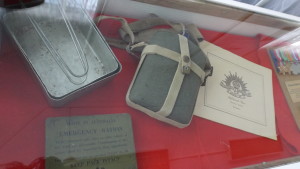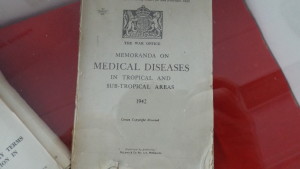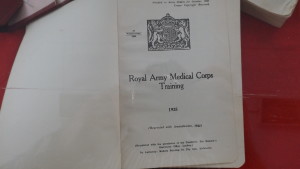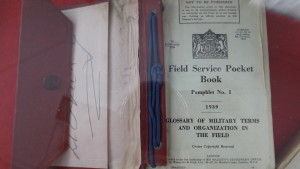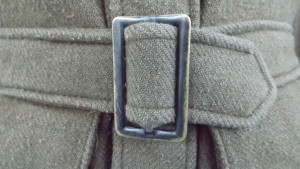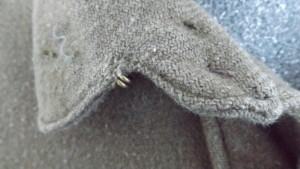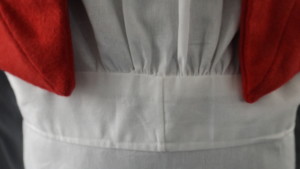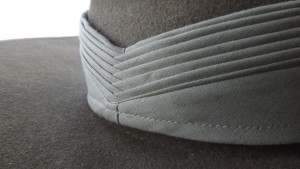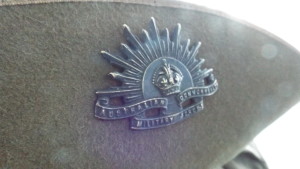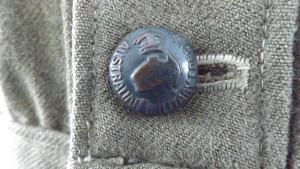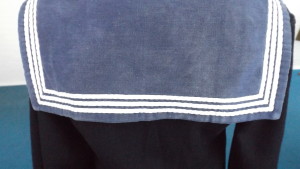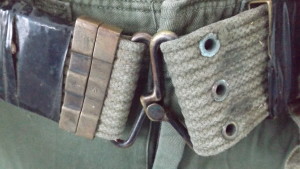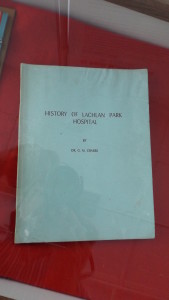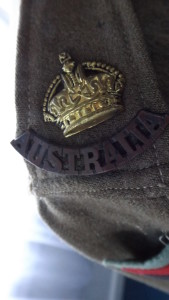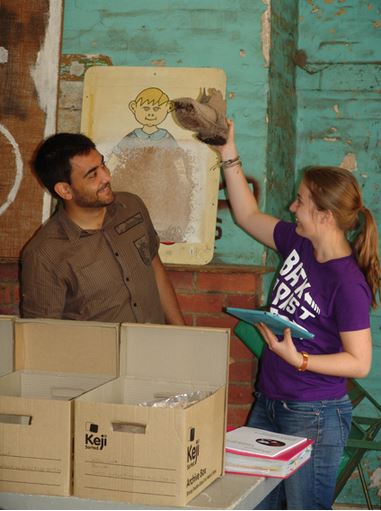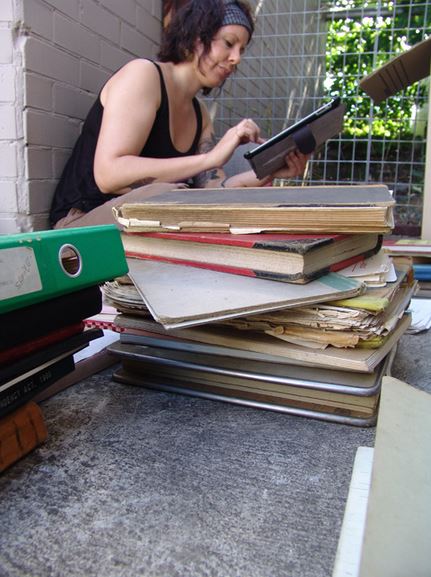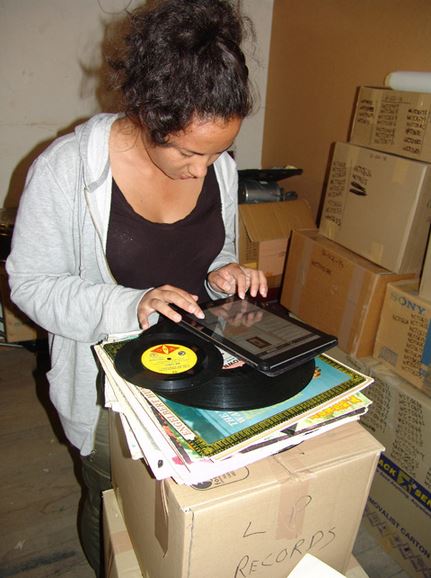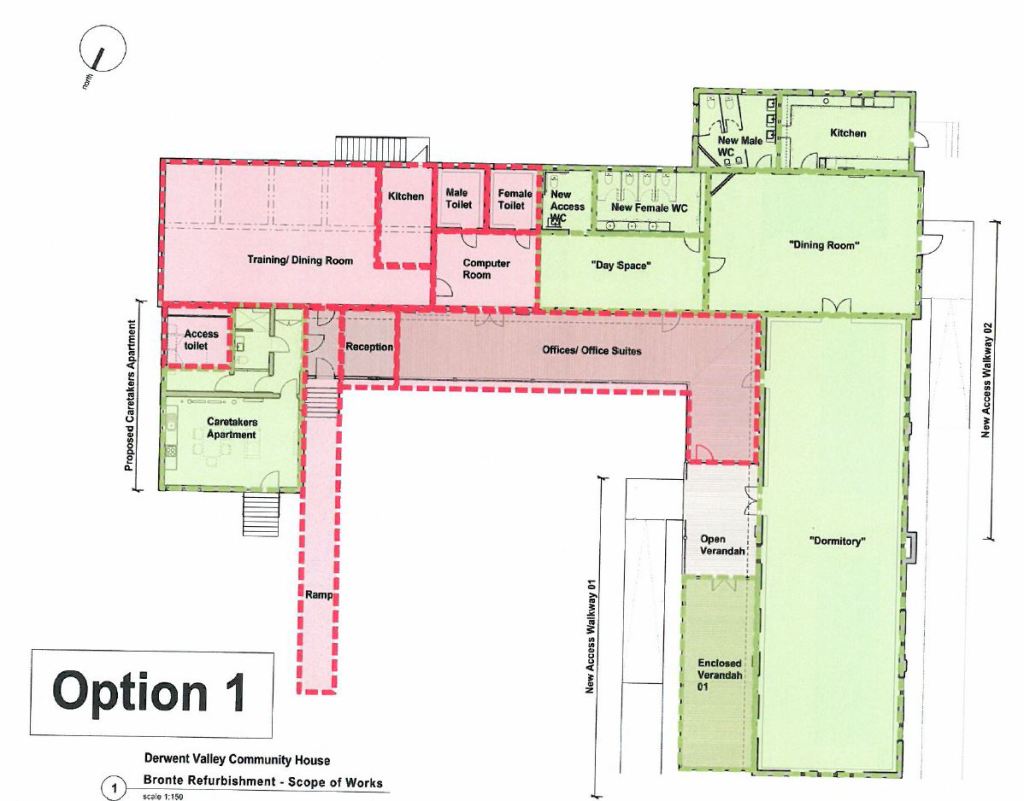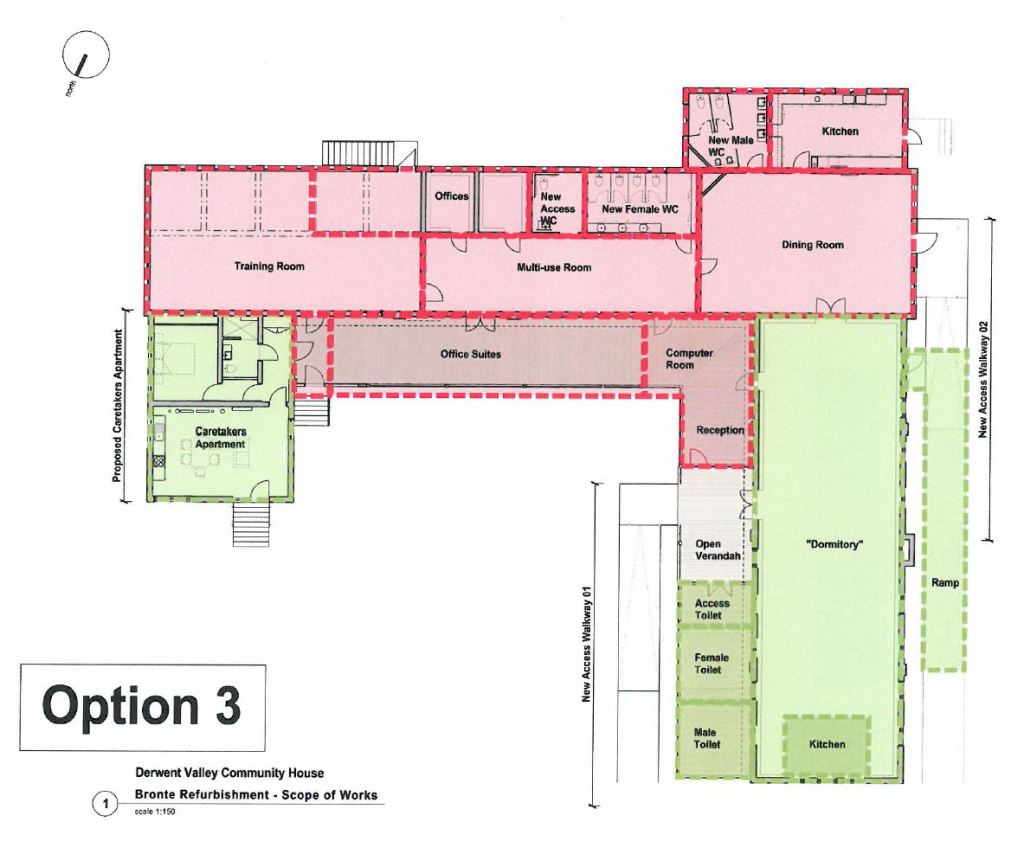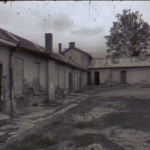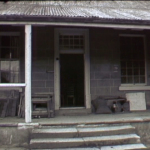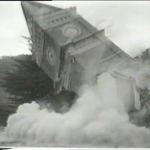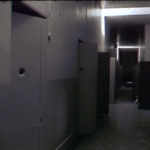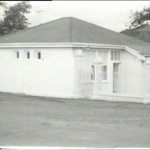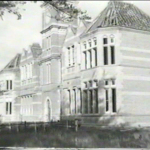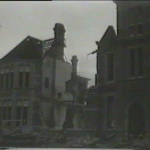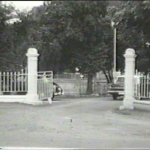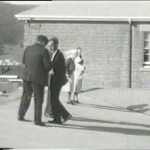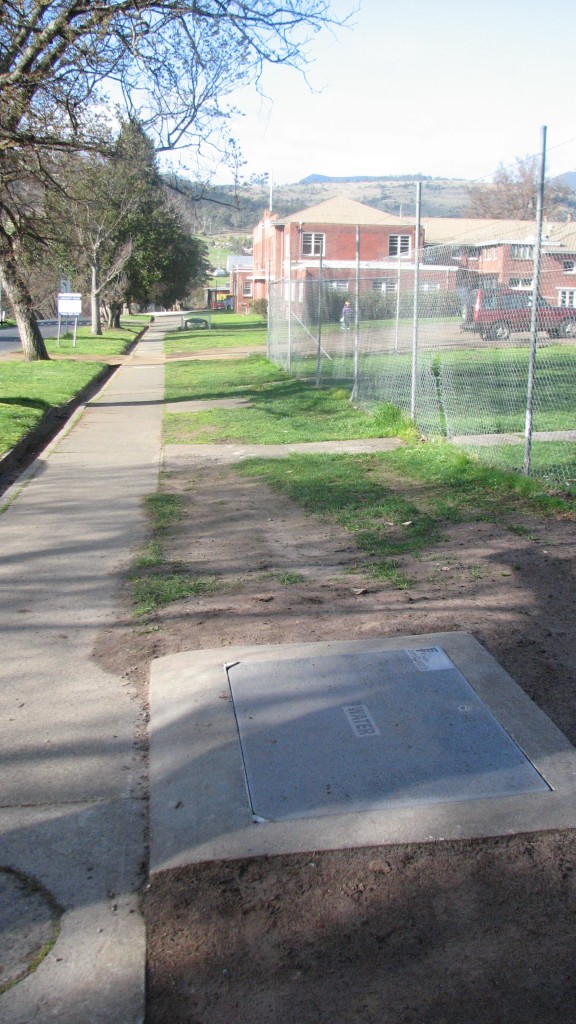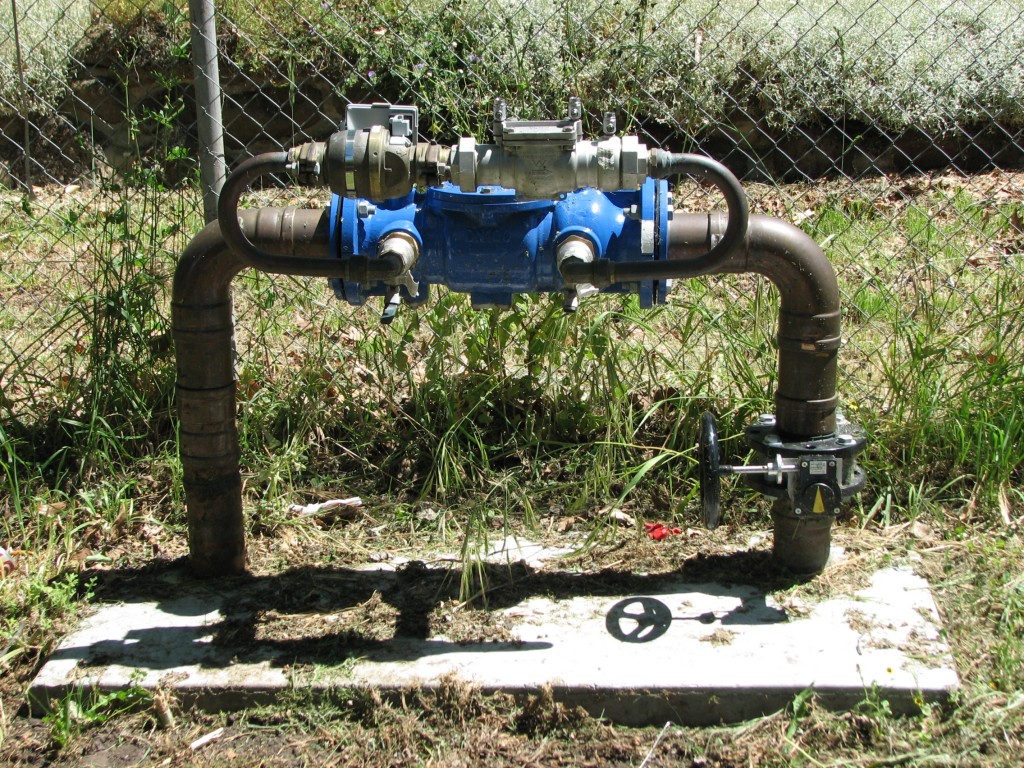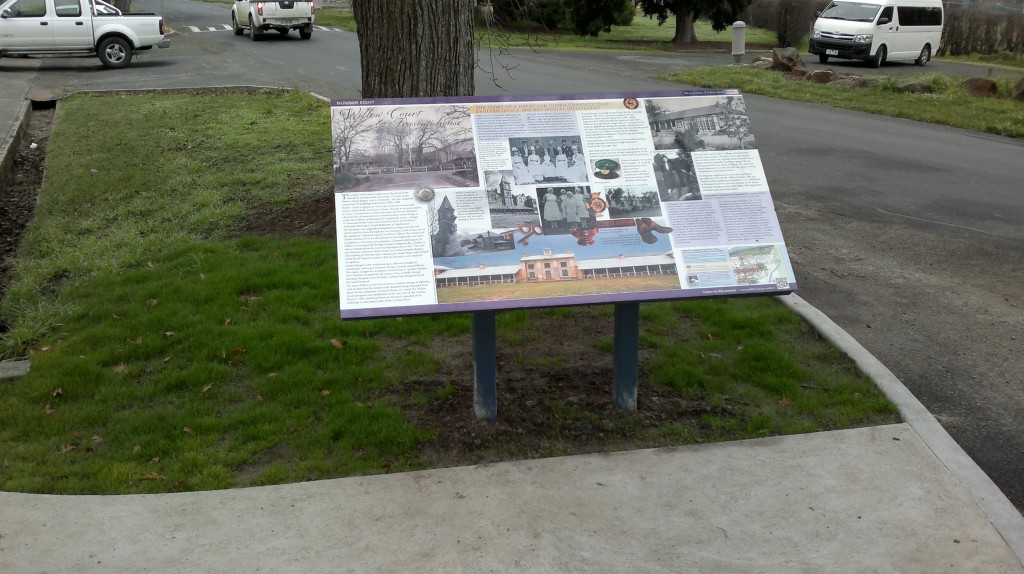What to do with so many “unbreakable” glass window panes? Make them into leaving gifts!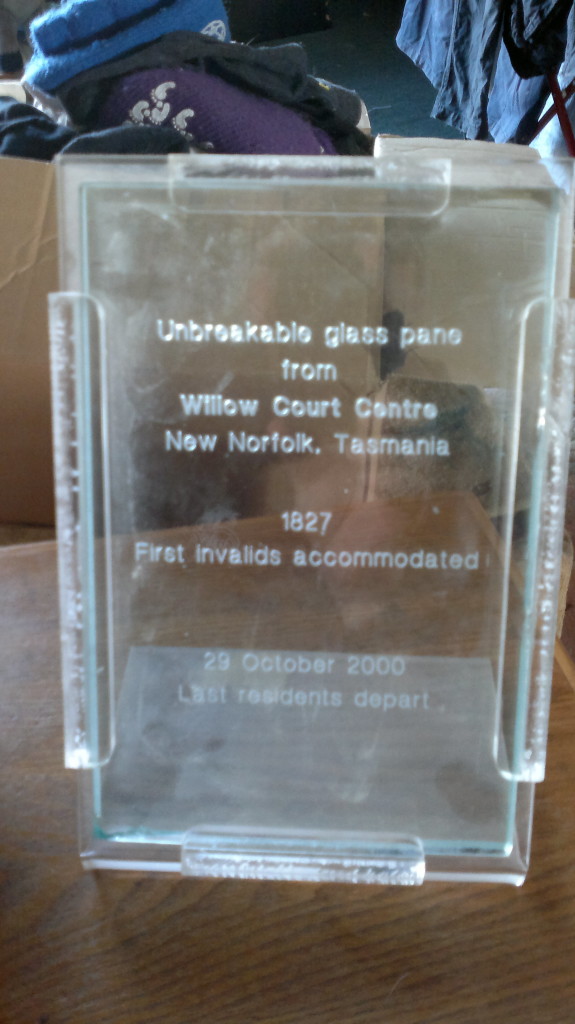
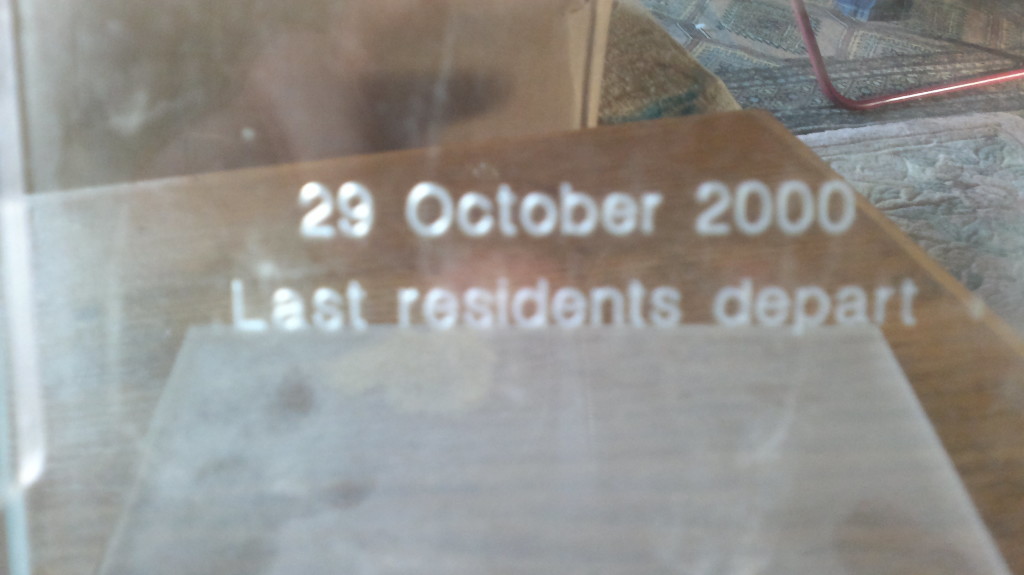
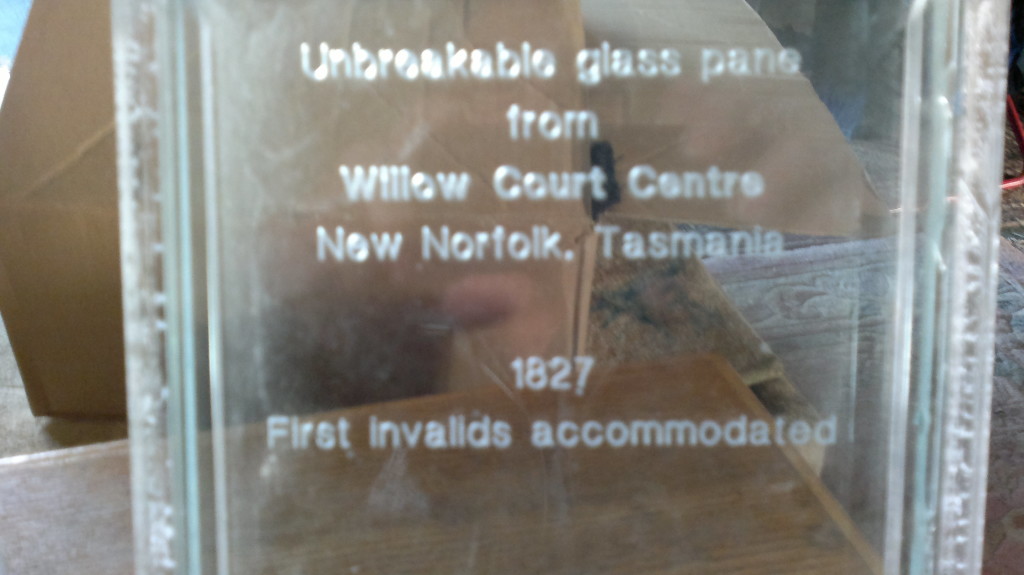 I saw this today at a friend’s house, her father, a highly respected advocate for people living with a disability both at Willow Court and later within the community, was presented with it after the closure in October 2000. The glass slabs were almost unbreakable and are about 1.5 cm thick and here it is mounted in a perspex frame and stand. While all things Willow Court/Royal Derwent Hospital are highly collectible, for some they also represent many years of dedicated service.
I saw this today at a friend’s house, her father, a highly respected advocate for people living with a disability both at Willow Court and later within the community, was presented with it after the closure in October 2000. The glass slabs were almost unbreakable and are about 1.5 cm thick and here it is mounted in a perspex frame and stand. While all things Willow Court/Royal Derwent Hospital are highly collectible, for some they also represent many years of dedicated service.
Last weekends display, Conflict and Consequences.
I just wanted to share with you the background to some of the display Conflict and Consequences and how we (Friends of Willow Court) were able to put it together last weekend. It was easy to get information about wars and times of conflict and it was easy to access documents that told us of the Hospital’s history but the challenge was to see where these two subjects intersected and the people who were involved. The research was done over a reasonable length of time and we had access to a Historian, the Archives Office of Tasmania, the Tasmanian Military Museum and private collector and also we had connections with families. These family connection were what was the most humbling because we were being told of family stories of pride, sorrow and pain. To be able to listen to each of these stories and come to an understanding of that place, that time, and that horror was educational and highly emotive for us, the researchers. A simple thanks doesn’t seem to suffice sometimes. We were able to show the completed stories to some of those families and that was a delight. For a short time we were able to understand the journey that they had to have and some continue to travel.
The history of mental health issues post war is well documented and now days is recognised as post traumatic stress disorder but previously throughout the history of this condition, could have been known as “shell shock”, “melancholy” or simply being “depressed”. It is a condition that some live with and for others it was too much to endure on the human spirit. The hospital’s admission rate increased during these time of world conflict as found in the graph below.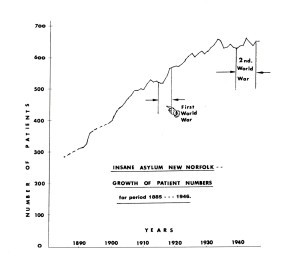 Matron Morey and others returned from areas of conflict themselves and either joined or rejoined the hospital staff. It was these people who supported those that came back only to find life too hard, especially after time spent in camps as a prisoner of war.
Matron Morey and others returned from areas of conflict themselves and either joined or rejoined the hospital staff. It was these people who supported those that came back only to find life too hard, especially after time spent in camps as a prisoner of war.
Some other interesting things we discovered during our research was that a lot of records were used as paper pulp because of the paper shortage experience at the time. Most of the paper was imported from Britain, even the Mercury and Examiner both wrote to the Hospital regretfully informing the administration that they could not longer supply free newspapers. Times were tough when you consider that was the main means of communication with events from abroad and locally. Some files were written on coloured paper as staff were asked to use and reused what ever paper they could including the carbon copies that were often different in colour than the original documents. Some records were also lost during the second world war in particular because of the need to make more paper and this was frustrating when Dr Crabbe came to write the history of Lachlan Park Hospital after his own war service and return after being a prisoner of war. He saw the files before he departed for war and on his return lots had gone. His book was on display last weekend and we had a voice over of the introduction (below).
Here is a small selections of photos of the display.
Updated Artifacts catalogue
The Archaeology Students from Flinders University have been busy updating and expanding the artifact list from the remaining artifacts. Some cross referencing is occurring with older catalogues and hopefully we will have a definitive list. The students are going through the recorded data and will present the work back as a finished catalogue as part of their assessment requirements in approximately a months time. Here are some of the pictures of the students laboriously sorting through and recording each item last week. One of the earlier lists was called the 1996 Inventory of Historical Items and there are some remaining items on that list that are recorded in the 2014 list. It is hoped that the artifacts can be used to tell the story and the history and serve as a tactile reminder of our past. Item are still being donated back to the hospital which will be included and recorded. Many items are still out in the community and each time this is discussed we are seeing more memorabilia appearing. Some of this was purchased at the large garage sales when Willow Court closed and there are many stories of items being taken in the last days and months of the institution’s life. I was believed that there were two oil painting of some considerable size and value that once were the property of the hospital. It is hoped that some of that held in private hands will somehow make its way back to Willow Court and will be managed by the Derwent Valley Council.
Derwent Valley Community House plans at Willow Court
The Derwent Valley Council have been asked to make a decision about co-locating the Derwent Valley Community House DVCH into the Heritage Precinct at Willow Court at the next meeting, according the the agenda on the DVC website. The plan put forward three options for co-location but doesn’t consider if this is the best long term out come for the Heritage site or the Derwent Valley Community House.
Willow Court is older than Port Arthur, which doesn’t contain anything like this proposal and has a specific vision to cater for the tourist market, a thought that we also have. We are concerned that knee jerk reactions are driving the DVC agenda instead of good long term planning for the site. The new Derwent Valley Council can lay this proposal on the table and review this decision and do what is best for both the Derwent Valley Community House and the Willow Court Heritage Site.
Some of the issues that have not been considered are the share facilities with school group tours and tourists.
Most schools require a checked and safe environment for young children. How can the DVC guarantee this will occur. It would be a bit hard to ask all DVCH users to complete a police check and a working with children check and would most likely be in appropriate.
Open access to any displays and exhibitions in the building and tours.
The DVCH is open all hours to cater to their market and peoples needs and wants, this is not the same as the Heritage Precinct’s needs, so securing valuable and very precious historic items or art works that are on display is not easy. During events and tours that are paid entry, do the users of the DVCH have free access to the heritage site?
Department of Health and Human Services having key funding and a say in the Heritage Precincts ongoing operations
The funding that come with moving the DVCH into Willow Court has stings attached and these need to be known, discussed and a simple consultation process entered into.
Once the site is Heritage listed, opportunities for funding for that next stage of preservation work are considered much greater, but how will having a sitting tenant in a Heritage listed site effect the ability for grants? How will having ten years of historical archaeology around the site affect the DVCH operations including archaeology digs sites?
At the height of the hospitals history there were 50 odd buildings but through fire sales, mismanagement, vandalism and arsonist work, what is left is is a small representation of what was. The DVC has a last opportunity to preserve Tasmania’s Mental Health and Disability history or what little is physically left.
Item 10.10 of the DVC agenda contains three options which I have included and each of these options come with a cost which will have to be met.
The alarming thing is this building is about to be handed back to the DVC as a finished project and now with this revised plan, a lot of extra work will have to take place, ramps built, kitchens and bathrooms, toilets and accessible facilities installed, including running sewage and sewerage into areas it is currently not installed.
How much more tax payer money needs to be spent before a final idea come to fruition?
Will the next lot of work close the site again and stop the public from seeing the work that has already been done?
Option 1 looks at the red areas being for the use of the DVCH and the Green areas being for multi-purpose area. Office suites are installed in the enclosed verandah area, this isn’t suited to the task during a cold winter in the valley. this option also requires a second kitchen to be installed for the community house in the rear of Bronte. The computer room and day space are installed in what is a hallway which will be disturbed with passing traffic. The Caretakers apartment is reduces in size to cater for an access toilet facility for DVCH guests and employees. No tours can be conducted through the DVCH areas, again reducing the size of the DVC owned and managed tourist area.
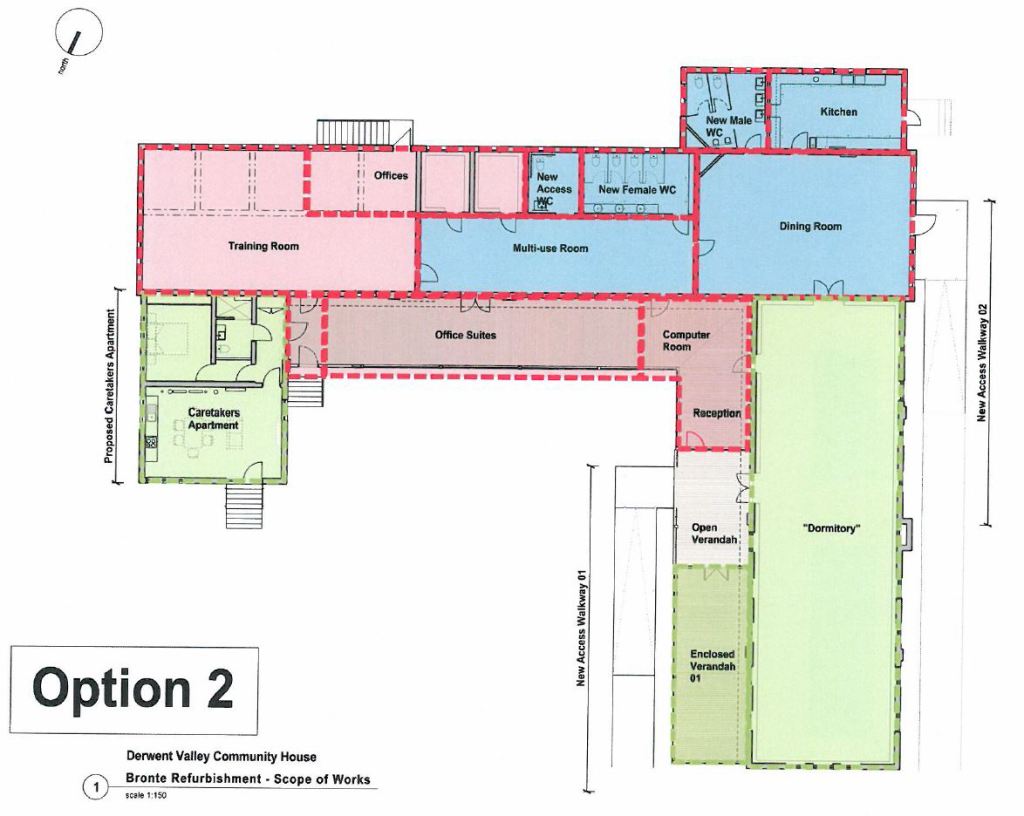 Option 2 introduces the idea of shared areas (blue area) and as discussed earlier, this raises all sorts of issues for school groups that access the site for education and could potentially put the participants of the DVCH programs at some level of discomfort. The multi-use area again sits just outside of the female toilets and in what was a hallway, this isn’t approprate at all. The office area again is in an inappropriate area for winter occupation. While option 2 is the least cost expenditure it is also the most inappropriate of all the options. No tours can be conducted through the DVCH areas, again reducing the size of the DVC owned and managed tourist area.
Option 2 introduces the idea of shared areas (blue area) and as discussed earlier, this raises all sorts of issues for school groups that access the site for education and could potentially put the participants of the DVCH programs at some level of discomfort. The multi-use area again sits just outside of the female toilets and in what was a hallway, this isn’t approprate at all. The office area again is in an inappropriate area for winter occupation. While option 2 is the least cost expenditure it is also the most inappropriate of all the options. No tours can be conducted through the DVCH areas, again reducing the size of the DVC owned and managed tourist area.
Option 3 separates the ares again and reduces the size of the facility to the Willow Court visitors and increases the cost significantly with the installation of a new kitchen, access toilet, and male and female toilets. The multi-use area is still in the hallway and outside of the female toilets, offices and access toilets. This was not built for such use. No tours can be conducted through the DVCH areas, again reducing the size of the DVC owned and managed tourist area.
The full plans and the agenda are available from the Derwent Valley Council website. We urge the Derwent Valley Council to stop, think and plan a vision with all your partners that will suit the long term good of all involved. Maybe it is time that this Tasmanian asset is give back to be managed by the Port Arthur Authority? The Derwent Valley Community House deserve better than a co-location, their work in the community is vital and should be given priority for a purpose build property with access for everyone and for their exclusive use, the same as these Community Houses:
Bridgewater Community Centre
Bucaan Community House
Clarendon Vale Neighbourhood Centre
Dowsing Point Community Centre
Dunalley/Tasman House
Gagebrook Community Centre
Geeveston Community Centre
Goodwood Community Centre
Karadi Aboriginal Corporation
Maranoa Heights Community Centre
Okines Community House
Pittwater Community Centre
Risdon Vale Neighbourhood House
Rokeby Neighbourhood Centre
Warrane Mornington Neighbourhood Centre
West Moonah Community House
West Winds Community Centre
Old photos of Willow Court
Click on photos to scroll through
Two function Centres in Willow Court?
Willow Court is to have two function centres if this is approved, one at the privately owned area of Willow Court and the other was planned for the Heritage Precinct. The Derwent Valley Council has a public plan which includes a public function centre also in its own area just 100 m up the road. This must be a confusing decision for a council to approve a function centre next to their own proposed function centre. It is also believed that the Morgue Hotel idea is also up for approval with the Derwent Valley Council on the privately owned area. 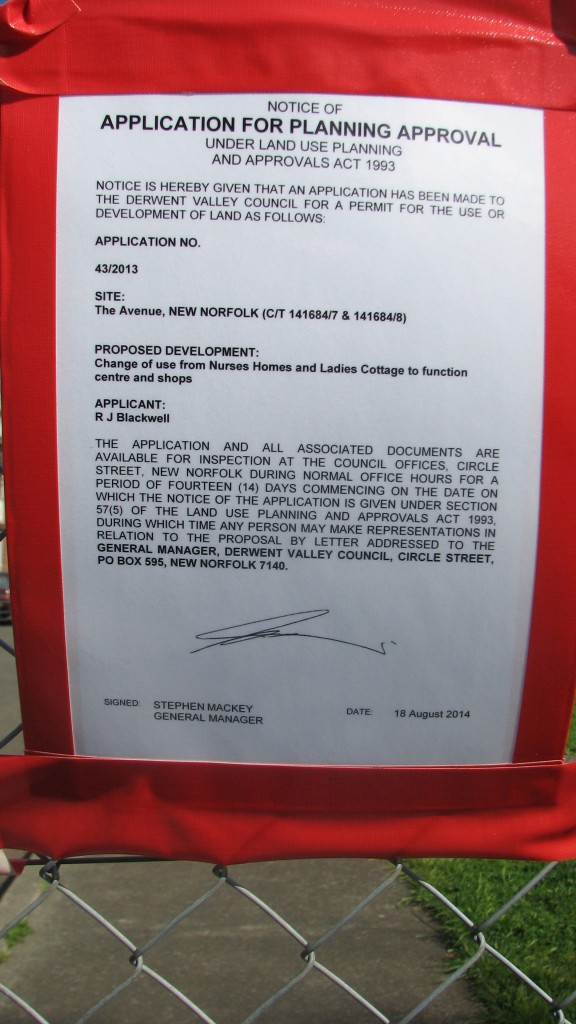
Pipes head underground
Recent water pipes installed by the new TasWater authority along the Avenue have caused some concern on this site when the ugly above ground pipe started appearing in and around the Heritage area of Willow Court. Even the Derwent Valley, a part owner of TasWater complained about the visual pollution that these caged pipes caused. Two of the caged pipes have recently been lowered underground to reduce the visual impact. There are still two above ground pipes in the Avenue, one outside the grounds of the privately owned section and the other outside the old Administration building. It is hope that the Derwent Valley Council will continue to demand that this visual pollution be re installed underground and direct any future works to be in keeping with the heritage plans.
A de-institutionalisation study from Willow Court from Respected Doctors
A Comprehensive Health Assessments During De-institutionalisation – An Observational Study: from respected Doctors, Nick Cooling and Nick Lennox. This study was done at Willow Court and highlights issues when monitoring the health needs of people with an intellectual disability.
“It is well known from other studies that sensory impairments are often unrecognised in both the institutional and community setting 24-28. The results of this study support this”.
This was collaborative study between Queensland Centre for Intellectual and Developmental Disability at the University of Queensland, the Southern Division of General Practice in Tasmania and Willow Court Centre in Tasmania.
Click here to view the full report, Health Study
Open day, possible delay
The last weekend in September is the intended open weekend, but due to some vandalism over the weekend this may be delayed. Apparently, ‘someone’ possibly climbed the fence, broke a window, stole cabling from conduit laid ready for the power that was to go on, then broke another window. Although vandalism is on a small scale at the moment, steps are in place for future prevention. We hope once caught that the Owner the DVC will prosecute for the destruction of this heritage property.
There will be meetings this week and next to plan for the event as scheduled in the hope that repairs will be complete
.
Moved sign to better location
The information sign on the corner of the Avenue and the entrance way to the Barracks has been relocated to it’s new site. This site is on the top side of the road closer to the entry and where there are newly added footpaths. The old site was in the grass on the slopes of the Lachlan River side of the entry way. This sign is also connected to the New Norfolk “Walking Through Time” Heritage Walking tours and audio podcasts. Find Podcast here.
With the new opening time proposed for September there is concern about where people who are visiting the site will park. The Friends of Frascati House have recently asked the Council to look into the issue of parking. With a lot of new activity there would be lots of new traffic issues along the Avenue. It is also unclear what long term plan the Derwent Valley Council have in place for the extra traffic congestion and disability parking as the “dirt to plate” project is expanding, Frascati house is restored, the old oval wards become residential accommodation with their own private parking and the community house continue with their activities.


